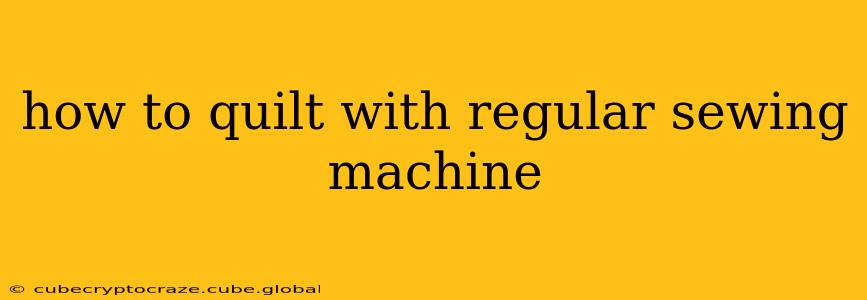Quilting, the art of stitching layers of fabric together, can seem daunting, but it's surprisingly achievable with a regular sewing machine. This guide will walk you through the process, answering common questions and providing tips for success. Whether you're crafting a simple throw or a complex masterpiece, this guide will empower you to bring your quilting visions to life.
What Kind of Sewing Machine Do I Need for Quilting?
You don't need a specialized quilting machine to get started. A standard sewing machine with a few key features will suffice:
- Adjustable stitch length: This allows you to control the density of your stitching, crucial for different quilting techniques.
- Adjustable presser foot pressure: This helps to feed the layers of fabric evenly, preventing puckering, especially important when working with multiple layers.
- Free arm: While not essential, a free arm allows for easier maneuvering around curved edges and smaller projects.
While a walking foot is a fantastic addition for larger projects (we'll discuss this later), it's not a necessity for beginners.
How Do I Prepare My Fabric for Quilting?
Proper preparation is key to a successful quilting project. Here's a step-by-step guide:
- Choose your fabrics: Select your top fabric (the patterned layer), your backing fabric (the reverse layer), and your batting (the fluffy middle layer). Ensure your fabrics are pre-washed to prevent shrinkage after quilting.
- Cut your fabrics: Cut your top, batting, and backing fabrics to the same size, adding extra inches around all sides to account for seam allowances.
- Layer your fabrics: Layer your fabrics, placing the backing fabric face down, then the batting, and finally, the top fabric face up. Pin or baste the layers together to prevent shifting during stitching. Basting is highly recommended, especially for beginners.
What's the Best Way to Baste My Quilt Layers?
Basting secures your quilt layers together and is essential for even feeding and preventing shifting during the quilting process. There are three primary methods:
- Pinning: This is a good option for smaller quilts, but can be time-consuming for larger projects. Use plenty of pins, spaced evenly.
- Spray basting: Use a temporary adhesive spray to hold the layers together. This is quicker than pinning but requires careful application to avoid excessive spray.
- Hand basting: This involves using long, loose stitches to join the layers. It's the most time-consuming method but provides the most secure hold.
Choose the method that best suits your skill level and the size of your quilt.
What Stitches Are Best for Quilting on a Regular Machine?
Straight stitches are the workhorse of quilting, perfect for both piecing and quilting. Experiment with different stitch lengths to achieve varying densities.
- Straight stitch: Use a consistent stitch length for even quilting.
- Meandering stitch: A free-motion quilting technique (requires a darning foot) creates a decorative and functional stitch pattern.
Can I Use a Walking Foot for Quilting?
A walking foot is a fantastic attachment that helps feed multiple layers of fabric evenly, preventing puckering. It's particularly helpful for larger quilts and thicker batting. While not essential, it significantly improves the quilting process, especially for beginners.
How Do I Quilt in the Ditch?
"Quilting in the ditch" refers to stitching directly in the seam lines between your quilt blocks. This technique is straightforward and creates clean, crisp lines. It's a great option for beginners as it doesn't require intricate designs.
What Are Some Tips for Quilting on a Regular Sewing Machine?
- Take your time: Quilting requires patience. Don't rush the process.
- Use a sharp needle: A dull needle can damage your fabric and make stitching difficult.
- Use appropriate thread: Choose thread that's suitable for your fabric weight.
- Clean your machine regularly: This ensures smooth operation and prevents skipped stitches.
- Practice on scraps: Before starting your project, practice your quilting techniques on scraps of fabric.
By following these steps and tips, you'll be well on your way to creating beautiful, handcrafted quilts with your regular sewing machine. Remember, practice makes perfect! The more you quilt, the more confident and skilled you'll become. Enjoy the process!
